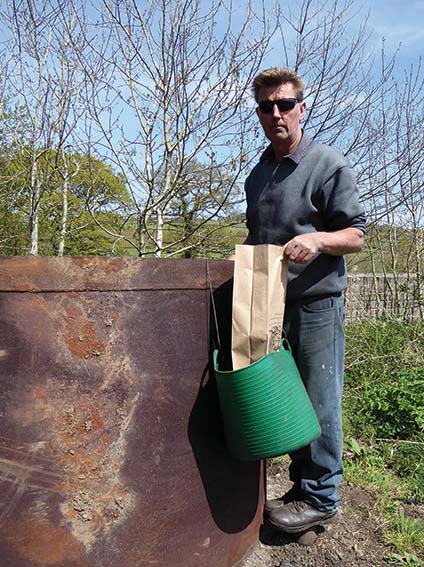Sunny days, long evenings, a barbecue at the beach? Sounds idyllic doesn’t it? But as we light the charcoal, do we ever think about where it comes from? I wanted to know, so I went to Higher Halstock to meet Dorset woodsman and charcoal burner, Rick Smith.
From Winyard’s Gap I followed a narrow lane downhill, past woodland and open pasture, between verges full with spring flowers. It was the first noticeably warmer spring day of the year and the low morning sunshine seemed to breathe new life in to the Dorset countryside. At the sign for Winford Rural Workshops I parked and went to look for Rick Smith. I found him leaning over one of his kilns, unloading charcoal in to sacks labelled “British Barbecue Charcoal”.
The origins of charcoal
Most people nowadays know charcoal for the richly glowing fire it creates in their barbeque, but the fuel has a long history and enabled one of mankind’s earliest technologies, the smelting of metals. Charcoal is made by heating wood in a low oxygen atmosphere so that it carbonises but does not burn; moisture and other volatile substances are driven off and eventually the large molecules making up the structure of wood are broken down, leaving the carbon and a little ash. Because charcoal is largely carbon, it burns in the presence of oxygen at a much higher temperature than wood and that’s one reason why it’s good for the barbecue.
The big discovery, several thousand years ago was that not only was a charcoal fire hot enough to melt and work metals but that the fire released pure metals such as copper from their ores. This is smelting, a technology that allowed man to move from the Stone Age to the Bronze Age. The same basic technology continued to be used, with charcoal as a fuel, until the beginning of the 18th century when coke took over. Until that time, charcoal was made by skilled itinerant workers, charcoal burners, who lived solitary lives in woods where they could continually oversee their work. The craft of charcoal burning has been revived by a handful of people in Dorset, and Rick Smith is one of these.
Charcoal burning
Rick showed me the kilns he uses for making charcoal (charcoal burning). These are large metal cylinders about 3 metres in diameter set in to the ground with several ports at ground level that allow air to enter and escape. Each kiln is filled with wood, dried outdoors for a year before use and arranged in the kiln so that air can circulate. The fire is started by pouring lighted charcoal in to the centre of the kiln and the lid is placed loosely on top. Rick watches the fire spread through the wood and once it is uniform, he seals the lid and places chimneys on half the ports to act as flues. Air in the kiln can be regulated through the other ports and kept at a low level so that the wood is carbonised but not burnt. The experienced charcoal burner knows the state of the fire from the colour of the smoke.
The kilns need to be watched carefully throughout this phase of the burn which lasts 12-18 hours, and Rick stays on site in a cabin for the entire period. I wondered how he felt about this commitment.
“It’s part of the job, but anyway, this is an amazing place to be, especially at night” he explained “no noise pollution, no light pollution, just imagine the stars!”
When the colour of the smoke changes from white to blue, Rick knows that the conversion of wood to charcoal is complete; he seals the kiln completely and allows it to cool for another 24 hours. The fuel is then ready to use, a jumble of pieces of charcoal, still retaining the original shape of the wood but now a mosaic of greys, blacks and silvers.
Coppiced woodland
Most of the wood used in Rick’s kilns comes from woodland adjacent to the site. This is ancient semi-natural broadleaf woodland containing mainly blackthorn and hazel, managed by the traditional technique of coppicing where trees are cut to the ground periodically and the stool left to regenerate. New shoots grow vigorously providing they are protected from browsing deer, forming multiple new stems which are ready to be cut again and used for charcoal burning after 7-10 years. Because there is continuous renewal, coppicing is a sustainable process; it also keeps the wood light and airy, encouraging wildlife among the trees and on the woodland floor. When I visited, the woods were a tapestry of bluebells and celandine, birds were singing and bumblebees were feeding from yellow archangel.
Barbecue charcoal—think before you buy
The British love affair with the barbecue consumes a massive 60,000 tons of charcoal each year, 90% of that being imported. Namibia is the UK’s biggest supplier and much of this charcoal is produced under dismal circumstances using illegally harvested trees leading to deforestation and lack of sustainability; working conditions are deplorable and archaic equipment is used causing damage to both the environment and to workers’ health. Major supermarkets buy imported charcoal in bulk to drive down prices but at least they now require that the product bears the FSC (Forest Stewardship Council) label; this provides some oversight of production methods but the labelling system seems far from watertight. Non FSC charcoal is still imported in to the UK for barbecues and the restaurant trade.
British Barbecue Charcoal, the sort Rick Smith produces, avoids all of these problems: it is produced using sustainable methods that support rather than destroy ancient woodland; it often contains a higher percentage carbon than the imported product so that it burns better and, when you buy locally, carbon emissions from transport are minimal compared with the 5000 mile journey from Namibia. Home-produced charcoal is widely available and buying the local product supports local employment. What could be better?








